#tomato purée
Explore tagged Tumblr posts
Text



[BIG POT, TOMATO PURéE. (as Arnold Schwarzenegger) I PUT IT IN THE BOWL, BUT BRING YOUR TORCHES. BRING YOUR TORCHES!]
#s11e11 from mozz to matzo balls#guy fieri#guyfieri#diners drive-ins and dives#tomato purée#big pot#arnold schwarzenegger#the#bowl#torches.
3 notes
·
View notes
Text
tomato soup and shepards pie tonight fwm fwm fwmmmmm

#ROASTED tomatoes AND garlic btw. if you even fucking care#rosemary n bay leaf (i added a carrot because i misread the recipe and didn’t get 4 pounds of tomatoes only 3)#salt n pepper#chicken stock cream purée that bitch!!!!!#sun dried tomatoes too#which i could t find at aldi so this doesn’t have it regrettably#tomatoe paste and onion and celery and fucking uhhh tomato juice too!
63 notes
·
View notes
Text
learnt an easy as fuck soup recipe that takes like 5 minutes and is so healthy it’s so good man……….
#vegetable stock cube tomato purée salt chilli flakes basil and water + udon noodles#also some garlic
6 notes
·
View notes
Text
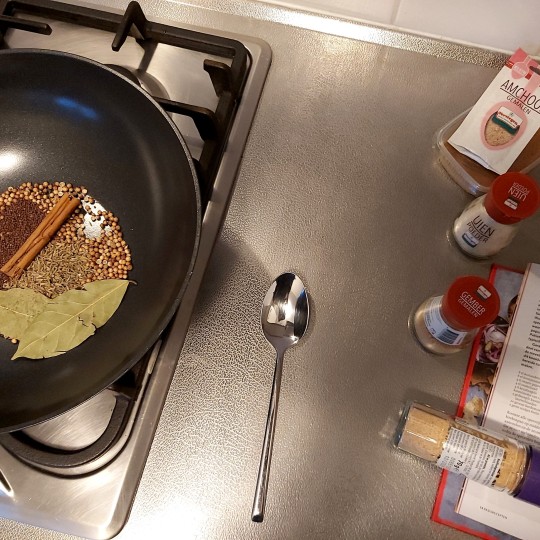

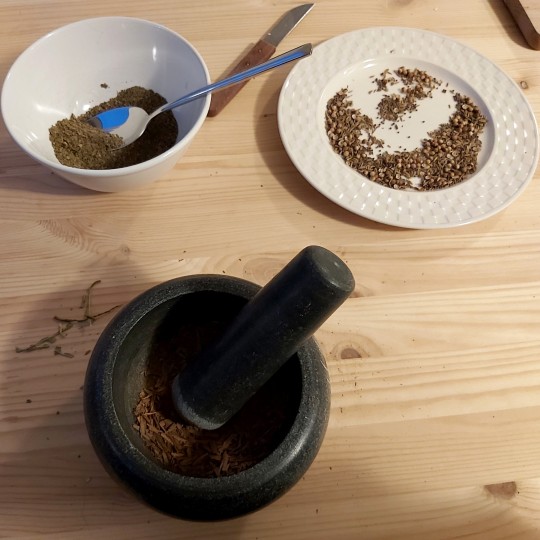
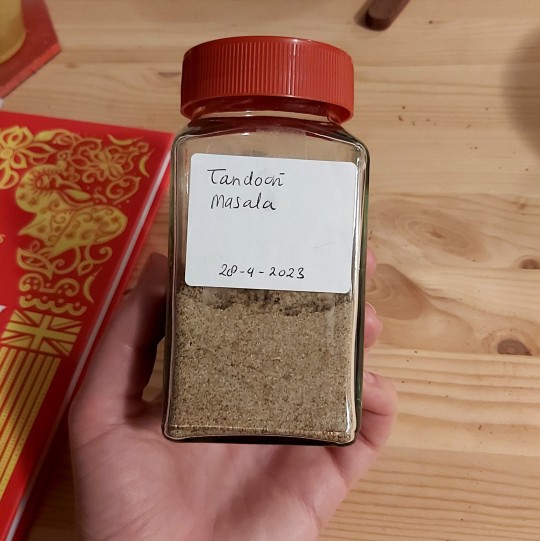
i made my own tandoori masala mix! you won't BELIEVE how pleased i am right now!!
#and i have ginger & garlic paste and tomato puré in cubes in the freezer... i feel as if i'm anthony bourdain#photo journal#food#stuff i make
58 notes
·
View notes
Text

Fried green tomato medley with a fire roasted red pepper purée
#memphis#collierville#Tennessee#chef#personal chef#chef jmf#art#food#tomatoes#fried green tomatoes#red pepper purée
2 notes
·
View notes
Text






60+ Vegan Sauces and Dips
0 notes
Text





[WOR-CHE-CHE-CHE-CHE. THEN WE MIX THIS UP. AND THEN WE ADD THE PURéED TOMATOES. SO NO KETCHUP GOES IN THIS. BOUGHT US ALL WITH YOUR DOUGH. WE LIKE TO DO IT OUR WAY. ALL RIGHT. SO WE GET ALL THAT MIXED IN. SMELLS GREAT. LET THIS SIT THERE AND SIMMER?]
#s10e05 wings dogs and claws#guy fieri#guyfieri#diners drive-ins and dives#puréed tomatoes#the#ketchup#dough#way#right#smells#great#simmer
3 notes
·
View notes
Note
what do you usually make for dinner? i’m looking for new things to try and the food you show in your photos always looks so tasty
Hi :) I have very seasonal menus, here are some of my go-to summer dishes:
Rice salad with lentils, maize, tomatoes, hard-boiled egg, rocket. My salad dressing is olive oil + sunflower oil + cider vinegar + Dijon mustard + whatever herbs I have at hand (usually thyme, basil, sage, rosemary)
I also make a salad-salad with the same dressing but with just lettuce and some rocket + walnuts + goat cheese + my homemade spicy plum-raisin chutney, or a fig chutney. Classic but delicious.
My laziest salads are potato-herring-red onions salad, or just grated carrots & black radish (and dressing obvs)
I love cold tomato soup in summer—I don't think I'm allowed to call it gazpacho because I don't like cucumber and have banished it from this recipe. It's just normal tomato soup with some olive oil, onion, garlic, Espelette pepper, and herbs, and I keep it in the fridge. I'm proud to say all the ingredients save the olive oil are from my greenhouse! Cold beetroot soup is also great, I often have cold soup with croûtons + a hard-boiled egg for supper (and then cheese + bread, and often dark chocolate + bread for dessert if I haven't made any dessert. Plus a fruit)

The chocolate tart I described here is to be eaten cold so it's a nice summer dessert (and breakfast). I keep carrot cake in the fridge too and since my recipe makes for a very moist cake it's very refreshing (I am positive I shared this recipe on here before but tumblr's blog search is useless :( It's my abuela's pastel de zanahoria esponjoso made with biscuit crumbs instead of flour, it's somewhere on this blog I swear, I remember illustrating it with a little carrot drawing 😭)
Another refreshing summer dessert is compote (or do you call it fruit purée?) Right now my favourite flavour is apple-plum (mostly because that's what I currently have and your own fruits always taste better<3) I just put a few (three?) apples to cook in a pan with a bit of water, a couple of tablespoons of sugar, a dash of lemon and a bunch of red plums, let it cook then blend it and put it in the fridge. Three weeks from now I will be drowning in blackberries and apple-blackberry will be my favourite flavour.
Quiche!! Endless possibilities with quiche. I like to make a quiche-ratatouille combo—I start with sautéing whatever vegetables I have (often courgettes, tomatoes, a couple of potatoes, maybe an aubergine & bell pepper, + Espelette pepper, onions, basil) in a pan with some olive oil; while it's cooking I prepare the body of the quiche in a bowl (20cL of milk, 2 or 3 tablespoons of flour, 2 eggs, some herbs and a tiny bit of olive oil for luck). I make a pie crust with flour, water, salt, oregano and olive oil (sorry I'm from the Mediterranean, I put herbs and olive oil everywhere). I spread the ratatouille on the pie crust then add the milk/egg mixture on top of it, then add little bits of cheese on top (gruyère or bleu or St Nectaire personally). I eat it with a side of rocket, it's perfect. And very colourful:

When I'm too lazy to do the ratatouille (and quiche) steps I just make a tomato tart—the same pie crust as above, then I spread Dijon mustard over it then cover it with sliced tomatoes, and add some (obligatory) herbs and olive oil. It's less effort and also looks very summery:

Some favourite autumn-spring dishes: vegetable lasagna, chilaquiles, hachis parmentier with mashed pumpkin, fish brandade, potato-courgette gratin (with blue cheese)... Then winter is for comfort foods like camembert fondue, risotto, calzones, pumpkin-chestnut soup, and crêpes—the savoury kind with sarrasin flour, what we call galettes. I grew up eating a ton of fish and seafood but I've curbed this habit due to environmental worries—hence why I'd like to raise edible fish in my greenhouse tanks! I get to eat a lot of eggs thanks to my hens, but I don't eat meat very often—hardly ever in summer except if I'm invited for dinner at someone's house. Sometimes I buy a homemade duck terrine from my neighbour and have a tartine for apéritif. My cold-season dishes call for ham in galettes and chicken in chilaquiles / risotto / quesadillas, and I make my hachis parmentier with duck. But yeah soup / salad / 'ratatouille quiche' and pasta with veggie sauce are my staples.
This list lacks pasta, I eat a lot of pasta. But mostly in autumn and spring; I just prepare my sauce in summer and store it for later. I also prepare & freeze a lot of soup and vegetable mash in summer with my greenhouse harvests. I often eat green beans as a side with my crêpes or other winter dishes because they grow so fast and incessantly in summer, my freezer ends up stuffed with bags of green beans. My usual pasta sauce is pretty much the same ratatouille combo as above (minus the potatoes so it's less thick), sauté'ed in a pan with olive oil, I also add an egg, parmesan (sometimes extra blue cheese or emmental) and liquid cream, then blend everything. I have a lot of courgettes and tomatoes right now, industrial quantities of basil and rocket, and beautiful Ecuador purple chili, so I've been making lots of jars of this sauce and also my new basil-rocket-cashew pesto! October-me will be thankful.
757 notes
·
View notes
Text
the milestone menu: roasted red pepper and tomato soup for sad days


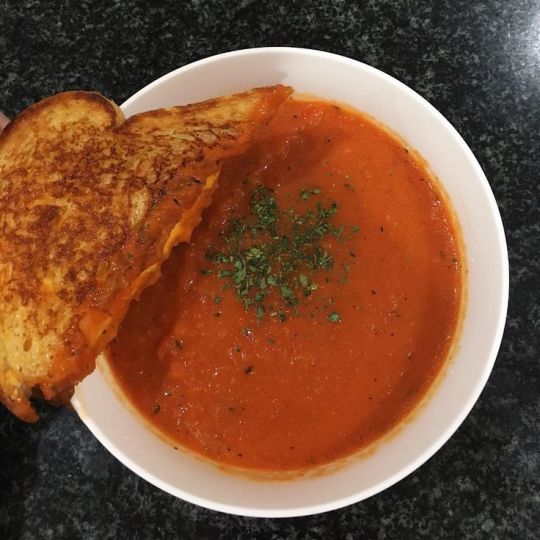
prompt: the death of mikey's anniversary is near. you make a comfort meal for carmen.
contains: mentions of death. angty with a side of fluff (at the end). anxious!carmen (i mean ofc).
INGREDIENTS
3 red bell peppers. 4 large tomatoes, peeled, seeded, chopped. An onion, chopped. 2 garlic cloves, minced
1 1/2 tsp thyme. 2 tsp paprika. A pinch of sugar. Salt & pepper. Cayenne
1/2 cup Chicken broth. 2 tbsp butter. 1 1/2 tbsp flour.
DIRECTIONS
Cover peppers in oil, broil until black, turn to get all sides. Put them in a paper bag to rest, the skin & seeds should come off easily. Chop. Heat oil on med heat in a large pot, cook garlic & onions until soft. Add tomatoes, peppers, thyme, paprika, and sugar. Cook on med-low, until most of the liquid has evaporated, about 20 minutes. Stir in 6 cups of chicken stock, salt & pepper. Bring to boil & simmer for 20 mins, until the vegetables are tender. Strain soup. Use a food processor or blender, and blend solids to your desired consistency. In your large pot, melt butter & add flour. Add soup/purée and stir, simmer for a few minutes.

“Hey, baby,” Carmen’s voice came to you before he did. A heavy sigh, tired and heavy from the day, from the looming anniversary approaching.
Mikey’s death date was creeping closer and closer, the days darker and colder as did Carmen’s demeanor. Longer days at work, distant even when he was home with you. You worried about him, though everyone told you not to.
“He just… he gets like this when it gets closer to the date, you know?” Richie muttered when you’d confided in him at family dinner. “We all get kinda fucked up, but Carm… That’s just how he is, y’know? Just give’im some time.”
Anchovy purred, rubbing against Carmen’s leg. It was almost like he knew. Carmen would swear he did, that he could sense his owner’s upset, that he was trying to make it better. He’s like you, Carmen would say, giving you a half grin that always had you swooning.
Carmen frowned when he didn’t see you lingering about. Not in the doorway smiling at them, leaning in for a kiss, wrapping him in a hug. “Babe?” Carmen called again, looking down the hall. The lights were on in the kitchen, a small clinking of bowls and silverware.
Carmen found you in front of the stove, trying to keep quiet, stirring a pan on the burner gently. “Hey,” He frowned when you jumped, turning around with a wide eyed gaze, like you’d been caught.
“Carm,” You chirped, body shimmying in front of the stove, too close to the flame in a too loose shirt. Carmen fought the urge to tell you to move or tuck your shirt in.
“You’re-You weren’t supposed to be home early.” You turned to the clock blinking on the microwave. “I-I thought you weren’t going to be home for another hour.”
“Richie told me to leave.” Carmen frowned, trying to peer around you.
“Why?” You blocked his view with your body, a side step in front of him.
“‘Cause he’s a fuckin’ jaggoff lately. What’re you doin’?” Carmen huffed lightly, grabbing your waist gently, holding you in place so he could see around you. A large pot on the stove, bubbling to life, steam clouding the clear lid that covered it.
“I’m cooking.” You huffed, shoulders deflating lightly. “I-I was going to surprise you. I had this whole thing planned, and I got candles and I was going to change out of this.” You threw your hands down on your sweatshirt- Carmen’s sweatshirt. One from Copenhagen he’d picked up when it was especially cold. You’d stolen in, not that he minded, he liked you better in it anyways.
“Was going to at least try to look a little nice.” You mutter, wiping off a small stain, a glob of tomato that had flung when the processor lid wouldn’t come off earlier.
“You look beautiful, c’mon.” Carmen shook his head at you. “What’re you- Why’re you doin’ all this?” His heart skipped for a moment, looking at the calendar pinned on the fridge. “Did I- We didn’t have plans?” Fuck, he’d been so busy he’d forgotten. Head everywhere but where it needed to be. First he was fuckin’ up dishes left and right at work, and now he couldn’t even remember a fuckin’ date.
“No,” You shook your head, stilling Carmen’s racing mind. “I just… I wanted to do something nice.” You looked up at him, hands grabbing him sweetly, holding them in your own. “For you.”
“For me?” Carmen whispered, swallowing around the tightness in his throat, in his chest. “What’re you talkin’ about for me? What-Why would you wanna-”
“Because,” You shrugged lightly, hands swinging between the two of you gently. “I just wanted to do something nice for you.”
Carmen saw the hesitation on your face, knew what was coming before you said it. He tensed in your hold. “I just… With everything-”
“-Don’t.” Carmen shook his head, the burn in his throat strangling his voice. “You don’t have to, baby.”
“I do.” Your eyes met his, rounding in his gaze. “I want to. I-I don’t really think it will help, but… I don’t know. Whenever I was sad my mom would make this for me.” You nod back towards the pot on the stove. “It always made me feel better.”
Carmen thought he might cry. He willed himself, squeezing your hands, pulling you into his chest to hold you. He just needed to hold you, to feel you, pressing his nose to your scalp, inhaling your scent.
All the emotions he’d repressed, swallowed down and tried to power through. Anytime he’d turn the corner, see Mikey’s smiling face on the fall and he’d feel like breaking down. Screaming, crying, punching the walls, pulling his hair out, ears ringing and heart hammering; instead, he’d go to the walk-in to breathe through collapsing lungs.
You felt Carmen’s shaky breath, rattle out of his chest and shake into yours. Your hand rubbed gently against his back, up his spine in a soothing way you hoped would calm him.
“I’m sorry.” You whispered, cheeks pressed against his chest. His heart raced in your ear, a pounding thud that made your own heart squeeze. “I’m so sorry, Carm.”
“It’s alright.” Carmen gritted, jaw clenching, willing his tears back. “It’s-it’s just a lot. I don’t even fuckin’ know why. Why-Why I even get like this when-when it’s been so long.”
“Don’t do that.” You shook your head, frowning at him lightly.
“No, no it’s true. I- fuck, I shouldn’t be-”
“-Carmen,” You held his gaze firmly. His red rimmed blue eyes met yours, a little wary, vulnerable. You softened, fingers brushing through his hair. “It’s ok.”
The finality in your voice, soft but certain, it made Carmen’s jaw shake, emotions bubbling over. He held you, rocking side by side in the kitchen, cries muffled into your shoulder. You held him back, just as tight, cooing shushes over the hums of the appliances, his tears wet on his sweatshirt- your sweatshirt.
“Don’t expect a lot.” You gave a small, teasing smile over your shoulder.
Carmen had settled into his usual seat at the small kitchen table. He’d sheepishly wiped his tears, letting you dote on him sweetly. Kiss his tears away, soft lips pressing to his wet cheeks, his nose, pulling him in so his lips were on yours, arms still tangled around the other.
“It’s not, like, gourmet or anything.” You shook your head, ladling out the hot liquid into a bowl. “It is my Nana’s recipe though.”
“Better than gourmet then?” Carmen’s voice was raspy with dried tears, though he smiled lightly. Bright enough to warm your heart, leave you smiling, plating the grilled cheese.
“She’d love that you said that.” You grin, setting the steaming bowl and sandwich in front of him. You leaned over, pressing a soft kiss to his cheek, a hand running down the back of his neck lovingly.
He burned at the simplicity, the sweetness of it all. So loving and affectionate freely, without any strings attached. Mikey would’ve loved you, Carmen was so sure of it.
“This is good.” Carmen nodded, swallowing his spoonful.
“Yeah?” You grinned proudly, positively beaming.
Of course it was good, the best fuckin’ thing he’s ever had. It came from you, so it only made sense it was. Carmen didn’t say that. Instead, he smiled, reaching over for your hand, squeezing it across the table. “Yeah. Amazing. Just what I needed.” He swallowed another wave of tears, happier this time. “Thank you for, uh, for doin’ this.”
“I’m glad you like it.” You propped your head in your free hand, a lopsided, lovey smile that warmed Carmen from the inside out. He knew his cheeks were blushing, tingling pink under your affectionate gaze.
“It’s really good.” Carmen took another spoonful, the warmth spilling down his throat, soothing his chest. “Sorry I came home early and didn’t call. I just… I’ve been out of my mind, y’know? I’m sorry about that too, it’s-it’s not fair to you, and-”
“-Carm,” You squeezed his hand lightly, fingers intertwining with his. “I’m glad you like it.” You smile sweetly.
Carmen nodded, leg still shaking under the table. He didn’t let go of your hand, held it in an iron grip like a lifeline and you let him, thumb sweeping over his inked knuckles calmly.
If Mikey could see him now, he’d be howling in laughter, cackling at Carmen at how “whipped” he was. Mercilessly tease him for being “soft” in a way that only a big brother could. But he knew Mikey would be so proud, so fuckin’ happy that Carmen found you- that Carmen had someone like you.
#the milestones menu#thebearer#bearblahs#carmen berzatto#carmen berzatto x reader#the bear#carmy berzatto x reader#carmy berzatto#carmen berzatto fluff#carmen berzatto angst#carmen 'carmy' berzatto#carmen berzatto x fem!reader#carmen berzatto x female!reader#carmen berzatto x you#carmen berzatto blurb#anchovy berzatto#richie jerimovich#michael berzatto#mikey berzatto#the bear fic#carmen berzatto fic#thebearerblurbs#the bear fx#the bear hulu
1K notes
·
View notes
Text
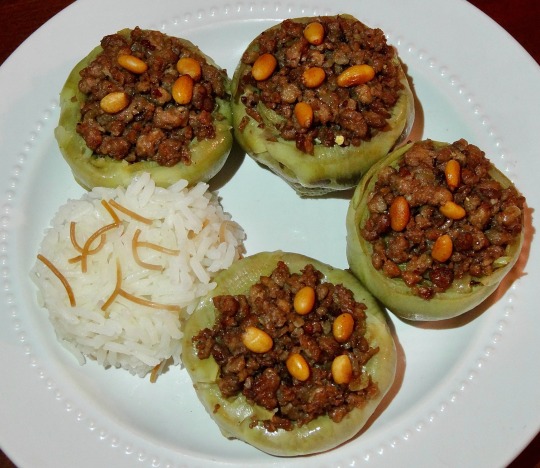
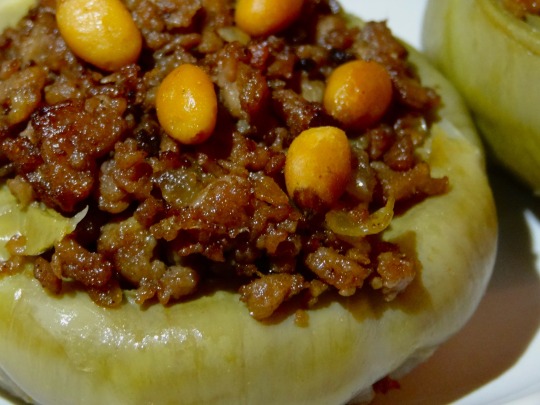
[ID: The first image is of four stuffed artichoke hearts on a plate with a mound of rice and fried vermicelli; the second is a close-up on one artichoke, showing fried ground 'beef' and golden pine nuts. End ID]
أرضي شوكي باللحم / Ardiyy-shawkiyy b-al-lahm (Stuffed artichoke hearts)
Artichoke hearts stuffed with spiced meat make a common dish throughout West Asia and North Africa, with variations on the recipe eaten in Lebanon, Syria, Palestine, Algeria, and Morocco. In Palestine, the dish is usually served on special occasions, either as an appetizer, or as a main course alongside rice. The artichokes are sometimes paired with cored potatoes, which are stuffed and cooked in the same manner. Stuffed artichokes do not appear in Medieval Arab cookbooks (though artichokes do), but the dish's distribution indicates that its origin may be Ottoman-era, as many other maḥshis (stuffed dishes) are.
The creation of this dish is easy enough once the artichoke hearts have been excavated (or, as the case may be, purchased frozen and thawed): they are briefly deep-fried, stuffed with ground meat and perhaps pine nuts, then stewed in water, or water and tomato purée, or stock, until incredibly tender.
While simple, the dish is flavorful and well-rounded. A squeeze of lemon complements the bright, subtle earthiness of the artichoke and cuts through the richness of the meat; the fried pine nuts provide a play of textures, and pick up on the slight nutty taste that artichokes are known for.
Terminology and etymology
Artichokes prepared in this way may be called "ardiyy-shawkiyy b-al-lahm." "Ardiyy-shawkiyy" of course means "artichoke"; "ب" ("b") means "with"; "ال" ("al") is the determiner "the"; and "لَحْم" ("laḥm") is "meat" (via a process of semantic narrowing from Proto-Semitic *laḥm, "food"). Other Palestinian Arabic names for the same dish include "أرضي شوكي محشي" ("ardiyy-shawkiyy maḥshi," "stuffed artichokes"), and "أرضي شوكي على ادامه" ("ardiyy-shawkiyy 'ala adama," "artichokes cooked in their own juice").
The etymology of the Levantine dialectical phrase meaning "artichoke" is interestingly circular. The English "artichoke" is itself ultimately from Arabic "الخُرْشُوف" ("al-khurshūf"); it was borrowed into Spanish (as "alcarchofa") during the Islamic conquest of the Iberian peninsula, and thence into English via the northern Italian "articiocco." The English form was probably influenced by the word "choke" via a process of phono-semantic matching—a type of borrowing wherein native words are found that sound similar to the foreign word ("phonetics"), and communicate qualities associated with the object ("semantics").
"Artichoke" then returned to Levantine Arabic, undergoing another process of phono-semantic matching to become "ardiyy-shawkiyy": أَرْضِيّ ("ʔarḍiyy") "earthly," from أَرْض ("ʔarḍ"), "Earth, land"; and شَوْكِيّ ("shawkiyy") "prickly," from شَوْك ("shawk"), "thorn."
Artichokes in Palestine
Artichoke is considered to be very healthful by Palestinian cooks, and it is recommended to also consume the water it is boiled in (which becomes delightfully savory and earthy, suitable as a broth for soup). In addition to being stuffed, the hearts may be chopped and cooked with meat or potatoes into a rich soup. These soups are enjoyed especially during Ramadan, when hot soup is popular regardless of the season—but the best season for artichokes in the Levant is definitively spring. Stuffed artichokes are thus often served by Jewish people in North Africa and West Asia during Passover.
Artichokes grow wild in Palestine, sometimes in fields adjacent to cultivated crops such as cereals and olives. Swiss traveler Johann Ludwig Burckhardt, writing in 1822, referred to the abundant wild artichoke plants (presumably Cynara syriaca) near لُوبْيا ("lūbyā"), a large village of stone buildings on a hilly landscape just west of طبريا ("ṭabariyya," Tiberias):
About half an hour to the N. E. [of Kefer Sebt (كفر سبط)] is the spring Ain Dhamy (عين ظامي), in a deep valley, from hence a wide plain extends to the foot of Djebel Tor; in crossing it, we saw on our right, about three quarters of an hour from the road, the village Louby (لوبي), and a little further on, the village Shedjare (شجره). The plain was covered with the wild artichoke, called khob (خُب); it bears a thorny violet coloured flower, in the shape of an artichoke, upon a stem five feet in height.
(Despite resistance from local militia and the Arab Liberation Army, Zionist military groups ethnically cleansed Lubya of its nearly 3,000 Palestinian Arab inhabitants in July of 1948, before reducing its buildings and wells to rubble, The Jewish National Fund later planted the Lavi pine forest over the ruins.)
Artichokes are also cultivated and marketed. Elihu Grant, nearly a century after Burckhardt's writing, noted that Palestinian villages with sufficient irrigation "[went] into gardening extensively," and marketed their goods in crop-poor villages or in city markets:
Squash, pumpkin, cabbage, cauliflower, lettuce, turnip, beet, parsnip, bean, pea, chick-pea, onion, garlic, leek, radish, mallow and eggplant are common varieties [of vegetable]. The buds of the artichoke when boiled make a delicious dish. Potatoes are getting to be quite common now. Most of them are still imported, but probably more and more success will be met in raising a native crop.
Either wild artichokes (C. syriaca) or cardoons (C. cardunculus, later domesticated to yield modern commerical artichokes) were being harvested and eaten by Jewish Palestinians in the 1st to the 3rd centuries AD (the Meshnaic Hebrew is "עַכָּבִיּו��ת", sg. "עַכָּבִית", "'aqubit"; related to the Arabic "عَكُوب" "'akūb," which refers to a different plant). The Tosefta Shebiit discusses how farmers should treat the sprouting of artichokes ("קינרסי," "qinrasi") during the shmita year (when fields are allowed to lie fallow), indicating that Jews were also cultivating artichokes at this time.
Though artichokes were persistently associated with wealth and the feast table (perhaps, Susan Weingarten speculates, because of the time they took to prepare), trimming cardoons and artichokes during festivals, when other work was prohibited, was within the reach of common Jewish people. Those in the "upper echelons of Palestinian Jewish society," on the other hand, had access to artichokes year-round, including (through expensive marvels of preservation and transport) when they were out of season.
Jewish life and cuisine
Claudia Roden writes that stuffed artichoke, which she refers to as "Kharshouf Mahshi" (خرشوف محشي), is "famous as one of the grand old Jerusalem dishes" among Palestinian Jews. According to her, the stuffed artichokes used to be dipped in egg and then bread crumbs and deep-fried. This breading and frying is still referenced, though eschewed, in modern Sephardi recipes.
Prior to the beginning of the first Aliyah (עלייה, wave of immigration) in 1881, an estimated 3% of the overall population of Palestine, or 15,011 people, were Jewish. This Jewish presence was not the result of political Zionist settler-colonialism of the kind facilitated by Britain and Zionist organizations; rather, it consisted of ancestrally Palestinian Jewish groups, and of refugees and religious immigrants who had been naturalized over the preceding decades or centuries.
One such Jewish community were the Arabic-speaking Jews whom the Sephardim later came to call "מוּסְתערבים" or "مست��ربين" ("Musta'ravim" or "Musta'ribīn"; from the Arabic "مُسْتَعْرِب" "musta'rib," "Arabized"), because they seemed indifferentiable from their Muslim neighbors. A small number of them were descendants of Jews from Galilee, which had had a significant Jewish population in the mid-1st century BC; others were "מגרבים" ("Maghrebim"), or "مغربية" ("Mughariba"): descendents of Jews from Northwest Africa.
Another major Jewish community in pre-mandate Palestine were Ladino-speaking descendents of Sephardi Jews, who had migrated to Palestine in the decades following their expulsion from Spain and then Portugal in the late 15th century. Though initially seen as foreign by the 'indigenous' Mista'avim, this community became dominant in terms of population and political influence, coming to define themselves as Ottoman subjects and as the representatives of Jews in Palestine.
A third, Yiddish- and German-speaking, Askenazi Jewish population also existed in Palestine, the result of immigration over the preceding centuries (including a large wave in 1700).
These various groups of Jewish Palestinians lived as neighbors in urban centers, differentiating themselves from each other partly by the language they spoke and partly by their dress (though Sephardim and Ashkenazim quickly learned Arabic, and many Askenazim and Muslims learned Ladino). Ashkenazi women also learned from Sephardim how to prepare their dishes. These groups' interfamiliarity with each other's cuisine is further evidenced by the fact that Arabic words for Palestinian dishes entered Ladino and Yiddish (e.g. "كُفْتَة" / "kufta," rissole; "مَزَّة" "mazza," appetizer); and words entered Arabic from Ladino (e.g. "דונסי" "donsi," sweet jams and fruit leather; "בוריק" "burek," meat and cheese pastries; "המים" "hamim," from "haminados," braised eggs) and Yiddish (e.g. "לעקעך" "lakach," honey cake).
In addition to these 'native' Jews were another two waves of Ashkenazi migration in the late 18th and early-to-mid 19th centuries (sometimes called the "היי��וב הישן," "ha-yishuv ha-yashan," "old settlement," though the term is often used more broadly); and throughout the previous centuries there had also been a steady trickle of religious immigration, including elderly immigrants who wished to die in Jerusalem in order to be present at the appointed place on the day of Resurrection. Recent elderly women immigrants unable to receive help from charitable institutions would rely on the community for support, in exchange helping the young married women of the neighborhood with childcare and with the shaping of pastries ("מיני מאפה").
In the first few centuries AD, the Jewish population of Palestine were largely farmers and agricultural workers in rural areas. By the 16th century, however, most of the Jewish population resided in the Jewish Holy Cities of Jerusalem (القُدس / al-quds), Hebron (الخليل / al-khalil), Safed (صفد), and Tiberias (طبريا / ṭabariyya). In the 19th century, the Jewish population lived entirely in these four cities and in expanding urban centers Jaffa and Haifa, alongside Muslims and Christians. Jerusalem in particular was majority Jewish by 1880.
In the 19th century, Jewish women in Jerusalem, like their Christian and Muslim neighbors, used communal ovens to bake the bread, cakes, matzah, cholent, and challah which they prepared at home. One woman recalls that bread would be sent to the baker on Mondays and Thursdays—but bribes could be offered in exchange for fresh bread on Shabbat. Charges would be by the item, or else a fixed monthly payment.
Trips to the ovens became social events, as women of various ages—while watching the bakers, who might not put a dish in or take it out in time—sent up a "clatter" of talking. During religious feast days, with women busy in the kitchen, some families might send young boys in their stead.
Markets and bakeries in Jerusalem sold bread of different 'grades' based on the proportion of white and wheat flour they contained; as well as flatbread (خبز مفرود / חובז מפרוד / khobbiz mafroud), Moroccan מאווי' / ماوي / meloui, and semolina breads (כומאש / كماج / kmaj) which Maghrebim especially purchased for the Sabbath.
On the Sabbath, those who had brick ovens in their sculleries would keep food, and water for tea and coffee, warm from the day before (since religious law prohibits performing work, including lighting fires, on Shabbat); those who did not would bring their food to the oven of a neighbor who did.
Palestinian Jewish men worked in a variety of professions: they were goldsmiths, writers, doctors, merchants, scientists, linguists, carpenters, and religious scholars. Jewish women, ignoring prohibitions, engaged in business, bringing baked goods and extra dairy to markets in Jerusalem, grinding and selling flour, spinning yarn, and making clothing (usually from materials purchased from Muslims); they were also shopkeepers and sellers of souvenirs and wine. Muslims, Jews, and Christians shared residential courtyards, pastimes, commercial enterprises, and even holidays and other religious practices.
Zionism and Jewish Palestinians
Eastern European Zionists in the 1880s and 90s were ambivalent towards existing Jewish communities in Palestine, often viewing them as overly traditional and religious, backwards-thinking, and lacking initiative. Jewish Palestinians did not seem to conform with the land-based, agricultural, and productivist ideals of political Zionist thinkers; they were integrated into the Palestinian economy (rather than seeking to create their own, segregated one); they were not working to create a Jewish ethnostate in Palestine, and seemed largely uninterested in nationalist concerns. Thus they were identified with Diaspora Jewish culture, which was seen as a remnant of exile and oppression to be eschewed, reformed, or overthrown.
These attitudes were applied especially to Sephardim and Mista'arevim, who were frequently denigrated in early Zionist literature. In 1926, Revisionist Zionist leader Vladimir Jabotinsky wrote that the "Jews, thank God, have nothing in common with the East. We must put an end to any trace of the Oriental spirit in the Jews of Palestine." The governance of Jewish communities was, indeed, changed with the advent of the British Mandate (colonial rule which allowed the British to facilitate political Zionist settling), as European political and "socialist" Zionists promoted Ashkenazi over Sephardi leadership.
Under the Ottomans, the millet system had allowed a degree of Jewish and Christian autonomy in matters of religious study and leadership, cultural and legal affairs, and the minting of currency. The religious authority of all Jewish people in Palestine had been the Sephardi Rabbi of Jerusalem, and his authority on matters of Jewish law (like the authority of the Armenian Patriarchate on matters of Christian law) extended outside of Palestine.
But British and European funding allowed newer waves of Ashkenazi settlers (sometimes called "היישוב החדש," "ha-yishuv ha-khadash," "new settlement")—who, at least if they were to live out the ideals of their sponsors, were more secular and nationalist-minded than the prior waves of Ashkenazi immigration—to be de facto independent of Sephardi governance. Several factors lead to the drying up of halaka (donated funds intended to be used for communal works and the support of the poor in Sephardi communities), which harmed Sephardim economically.
Zionist ideas continued to dominate newly formed committees and programs, and Palestinian and Sephardi Jews reported experiences of racial discrimination, including job discrimination, leading to widespread poverty. The "Hebrew labor" movement, which promoted a boycott of Palestinian labor and produce, in fact marginalized all workers racialized as Arab, and promises of work in Jewish labor unions were divided in favor of Ashkenazim to the detriment of Sephardim and Mizrahim. This economic marginalization coincided with the "social elimination of shared indigenous [Palestinian] life" in the Zionist approach to indigenous Jews and Muslims.
Despite the adversarial, disdainful, and sometimes abusive relationship which the European Zionist movement had with "Oriental" Jews, their presence is frequently used in Zionist food and travel writing to present Israel as a multicultural and pluralist state. Dishes such as stuffed artichokes are claimed as "Israeli"—though they were eaten by Jews in Palestine prior to the existence of the modern state of Israel, and though Sephardi and Mizrahi diets were once the target of a civilizing, correcting mission by Zionist nutritionists. The deep-frying that stuffed artichokes call for brings to mind European Zionists' half-fascinated, half-disgusted attitudes towards falafel. The point is not to claim a dish for any one national or ethnic group—which is, more often than not, an exercise in futility and even absurdity—but to pay attention to how the rhetoric of food writing can obscure political realities and promote the colonizer's version of history. The sinking of Jewish Palestinian life prior to the advent of modern political Zionism, and the corresponding insistence that it was Israel that brought "Jewish cuisine" to Palestine, allow for such false dichotomies as "Jewish-Palestinian relations" or "Jewish-Arab relations"; these descriptors further Zionist rhetoric by making a clear situation of ethnic cleansing and settler-colonialism sound like a complex and delicate issue of inter-ethnic conflict. To boot, the presentation of these communities as having merely paved the way to Zionist nationalism ignores their existence as groups with their own political, social, and cultural lives and histories.
Help evacuate a Gazan family with Operation Olive Branch
Buy an eSim for use in Gaza
Help Anera provide food in Gaza
Ingredients:
Serves 4 (as a main dish).
For the artichokes:
6 fresh, very large artichokes; or frozen (not canned) whole artichoke hearts
1 lemon, quartered (if using fresh artichokes)
250g (1 1/2 cups) vegetarian ground beef substitute; or 3/4 cup TVP hydrated with 3/4 cup vegetarian 'beef' stock from concentrate
1 yellow onion, minced
Scant 1/2 tsp kosher salt
1/2 tsp ground black pepper
1 pinch ground cardamom (optional)
1/4 tsp ground allspice or seb'a baharat (optional)
1 Tbsp pine nuts (optional)
Water, to simmer
Oil, to fry
2 tsp vegetarian 'beef' stock concentrate, to simmer (optional)
Lemon, to serve
Larger artichokes are best, to yield hearts 3-4 inches in width once all leaves are removed. If you only have access to smaller artichokes, you may need to use 10-12 to use up all the filling; you might also consider leaving some of the edible internal leaves on.
The meat may be spiced to taste. Sometimes only salt and black pepper are used; some Palestinian cooks prefer to include seb'a baharat, white pepper, allspice, nutmeg, cardamom, and/or cinnamon.
Medieval Arab cookbooks sometimes call for vegetables to be deep-fried in olive oil (see Fiḍālat al-Khiwān fī Ṭayyibāt al-Ṭaʿām wa-l-Alwān, chapter 6, recipe no. 373, which instructs the reader to treat artichoke hearts this way). You may use olive oil, or a neutral oil such as canola or sunflower (as is more commonly done in Palestine today).
Elihu Grant noted in 1921 that lemon juice was often served with stuffed vegetable dishes; today stuffed artichokes are sometimes served with lemon.
For the rice:
200g Egyptian rice (or substitute any medium-grained white rice)
2 tsp broken semolina vermicelli (شعيريه) (optional)
1 tsp olive oil (optional)
Large pinch salt
520g water, or as needed
Broken semolina vermicelli (not rice vermicelli!) can be found in plastic bags at halal grocery stores.
Instructions:
For the stuffed artichokes:
1. Prepare the artichoke hearts. Cut off about 2/3 of the top of the artichoke (I find that leaving at least some of the stem on for now makes it easier to hollow out the base of the artichoke heart without puncturing it).
2. Pull or cut away the tough outer bracts ("leaves") of the artichoke until you get to the tender inner leaves, which will appear light yellow all the way through. As you work, rub a lemon quarter over the sides of the artichoke to prevent browning.
3. If you see a sharp indentation an inch or so above the base of the artichoke, use kitchen shears or a sharp knife to trim off the leaves above it and form the desired bowl shape. Set aside trimmings for a soup or stew.
4. Use a small spoon to remove the purple leaves and fibers from the center of the artichoke. Make sure to scrape the spoon all along the bottom and sides of the artichoke and get all of the fibrous material out.
5. Use a paring knife to remove any remaining tough bases of removed bracts and smooth out the base of the artichoke heart. Cut off the entire stem, so that the heart can sit flat, like a bowl.
6. Place the prepared artichoke heart in a large bowl of water with some lemon juice squeezed into it. Repeat with each artichoke.
7. Drain artichoke hearts and pat dry. Heat a few inches of oil in a pot or wok on medium and fry artichoke hearts, turning over occasionally, for a couple minutes until lightly browned. If you don't want to deep-fry, you can pan-fry in 1 cm or so of oil, flipping once. Remove with a slotted spoon and drain.
8. Prepare the filling. Heat 1 tsp of olive oil in a large skillet on medium-high and fry onions, agitating often, until translucent.
Tip: Some people add the pine nuts and brown them at this point, to save a step later. If you do this, they will of course be mixed throughout the filling rather than being a garnish on top.
9. Add spices, salt, and meat substitute and fry, stirring occasionally, until meat is browned. (If using TVP, brown it by allowing it to sit in a single layer undisturbed for 3-4 minutes, then stir and repeat.) Taste and adjust spices and salt.
10. Heat 1 Tbsp of olive oil or margarine in a small pan on medium-low. Add pine nuts and fry, stirring constantly, until they are a light golden brown, then remove with a slotted spoon. Note that, once they start taking on color, they will brown very quickly and must be carefully watched. They will continue to darken after they are removed from the oil, so remove them when they are a shade lighter than desired.
11. Stuff the artichoke hearts. Fill the bowl of each heart with meat filling, pressing into the bottom and sides to fill completely. Top with fried pine nuts.
12. Cook the artichoke hearts. Place the stuffed artichoke hearts in a single layer at the bottom of a large stock pot, along with any extra filling (or save extra filling to stuff peppers, eggplant, zucchini, or grape leaves).
13. Whisk stock concentrate into several cups of just-boiled water, if using—if not, whisk in about a half teaspoon of salt. Pour hot salted water or stock into the pot to cover just the bottoms of the stuffed artichokes.
14. Simmer, covered, for 15-20 minutes, until the artichokes are tender. Simmer uncovered for another 5-10 minutes to thicken the sauce.
For the rice:
1. Rinse your rice once by placing it in a sieve, putting the sieve in a closely fitting bowl, then filling the bowl with water; rub the rice between your fingers to wash, and remove the sieve from the bowl to strain.
2. Place a bowl on a kitchen scale and tare. Add the rice, then add water until the total weight is 520g. (This will account for the amount of water stuck to the rice from rinsing.)
3. (Optional.) In a small pot with a close-fitting lid, heat 1 tsp olive oil. Add broken vermicelli and fry, agitating often, until golden brown.
4. Add the rice and water to the pot and stir. Increase heat to high and allow water to come to a boil. Cover the pot and lower heat to a simmer. Cook the rice for 15 minutes. Remove from heat and steam for 10 minutes.
To serve:
1. Plate artichoke hearts on a serving plate alongside rice and lemon wedges; or, place artichoke hearts in a shallow serving dish, pour some of their cooking water in the base of the dish, and serve rice on a separate plate.

Tip: The white flesh at the base of the bracts (or "leaves") that you removed from the artichokes for this recipe is also edible. Try simmering removed leaves in water, salt, and a squeeze of lemon for 15 minutes, then scraping the bract between your teeth to eat the flesh.
194 notes
·
View notes
Text


Tbf it’s more like stew
tfw you make pasta sauce but no pasta
#ghost posts#it’s got garlic onions spinach mushrooms pepperoni and mozzarella as the big ingredients#oh and strained/purée tomato#and then Italian seasoning salt/pepper and olive oil
10 notes
·
View notes
Text
Dick: *cooking*
*window lock clicks*
Dick: …..
Dick: *turns the flame up to full heat, throws in a full fish skeleton, pours in whole can of tomato purée and condensed milk*
Jason: Dick-
*fire alarm ringing from the smoke*
Jason: What the fuck are you making? Move! Don’t you know how to cook?!
Dick: Nope. But my baby brother is now here to help me!
Jason: …disgusting. Outta the kitchen
Dick: ��️
Based on this:

I headcanon that Nightwing can cook but he chooses not to because it’s easier. He doesn’t let people know because that’s another thing that will be expected of him and he already has too much on his plate so he just lets them assume he lives off cereal and takeouts. The batfam has never bothered to check because they’re too busy but Alfred knows he can cook because he taught Dick himself in the comics. Overall it’s just another aspect of his somewhat manipulative personality.
#this is not a diss#dick grayson#nightwing#jason todd#red hood#manipulative dick grayson#i love him for it#incorrect batfamily quotes#comic panels
634 notes
·
View notes
Text
Winchester bros. texting
Sam: Are you eating healthy?
Dean: Yes!
Dean: Today I made aged organic milk tossed over seasoned tomato purée spread on baked whole wheat
Sam: Wow let me see!
Dean:

Sam: wtf
#supernatural#spn#sam winchester#dean winchester#incorrect quotes#incorrect supernatural quotes#incorrect spn quotes
44 notes
·
View notes
Photo

Pasta Bake with Pumpkin Tomato Sauce Ingredients: 1 lb dry pasta of choice (mezzi rigatoni, shells, ziti, fusilli, or farfalle) 2 tablespoons butter 1/2 cup finely chopped walnuts 1 tablespoon plus 2 teaspoons finely chopped fresh sage, divided 2 tablespoons extra-virgin olive oil 8 oz cremini (baby bella) mushrooms, sliced 1 yellow onion, finely chopped 1/4 cup tomato paste 4 garlic cloves, minced 1/2 teaspoon crushed red pepper flakes 3-4 handfuls fresh baby spinach 1 teaspoon dried oregano 1 teaspoon kosher salt 1/2 teaspoon black pepper 1/4 teaspoon ground nutmeg 3 cups vegetable broth 1 (15-oz) can pumpkin purée 1/2 cup grated Parmesan cheese 1 1/2 cups grated fontina cheese, divided Instructions: Preheat Oven and Cook Pasta: Preheat oven to 375°F (190°C). Bring a large pot of generously salted water to a boil. Add pasta and cook until 2 minutes shy of al dente, keeping it slightly firm. Drain and set aside. Prepare Walnut-Sage Topping: In a large sauté pan over medium heat, melt the butter. Add walnuts and 1 tablespoon of chopped sage, cooking for about 5 minutes until walnuts are toasted and fragrant. Season with a pinch of salt and transfer to a bowl. Make the Sauce: Return the pan to medium heat. Add olive oil, mushrooms, and onion. Sauté until softened, about 8 minutes. Add tomato paste, garlic, and red pepper flakes, cooking for 3-4 minutes until tomato paste darkens and caramelizes. Gradually stir in spinach, cooking until wilted. Add oregano, salt, pepper, nutmeg, and the remaining 2 teaspoons of sage. Add Liquids and Cheese: Pour in vegetable broth, stirring to release any browned bits from the pan. Add pumpkin purée, Parmesan, and 1/2 cup of fontina cheese, stirring until the cheese melts and the sauce becomes smooth. Add cooked pasta and stir until noodles are well-coated with the sauce. Assemble and Bake: Transfer the pasta mixture to a greased 13x9-inch baking dish. Sprinkle remaining fontina cheese over the top, followed by the walnut-sage mixture. Cover with foil and bake for 15 minutes at 375°F. Uncover and bake for an additional 10 minutes, or until the cheese is melted and golden. Prep Time: 25 minutes | Cooking Time: 25 minutes | Total Time: 50 minutes Calories: 420 kcal | Servings: 6 servings This Pasta Bake with Pumpkin Tomato Sauce is a cozy, hearty dish that brings together the best of falls flavors. Each bite combines creamy, savory pumpkin sauce with a hint of nutmeg and fresh sage, and the addition of melted fontina cheese makes it even more indulgent. Topped with toasted walnuts and sage, it adds a delightful crunch that complements the creaminess of the pasta and cheese. Ideal for a cozy dinner or autumn gathering, this pasta bake is comforting and easy to prepare. The pumpkin and tomato base brings a unique depth of flavor thats perfectly balanced by the richness of the fontina cheese and buttery walnut topping. Serve it warm from the oven, and watch it become a favorite fall classic at your table.
#pastabake#pumpkinpasta#comfortfood#fallrecipes#cheesypasta#fontinacheese#autumnflavors#creamyanddelicious#sageandwalnuts#bakingrecipes#foodblogger#dinnerideas#cozymeals#warmdishes#seasonalrecipes#vegetariancomfort#pastaandcheese#flavorfulmeals#satisfyingdinner#fallcomfort#cooking#food#kitchen#recipes#snack#foodie#foodpics#bread#baking#recipe
20 notes
·
View notes
Text
9 dishes for cold days that will heat your soul
Capeletti soup - a warm soup is perfect for cold days and capeletti is known for its simplicity, flavor and comforting sensation.
Polenta - There's nothing better than polenta with ragú or minced meat on a cold day, accompanied by good cheese.
Risotto a la milanese - a classic risotto from the Milan region, prepared with arborio rice, saffron, meat broth, onion, butter and parmesan cheese, it is delicious!
Pumpkin cream soup - Pumpkin is a very tasty option for making creamy soups. This dish is even better with shredded chicken, croutons and gorgonzola!
Stuffed pasta - a tortéi or ravioli with tomato sauce and cheese could be the solution to accompany a ragú and make a perfect dinner!
Fondue - It is a popular option in the winter of the Rio Grande do Sul mountains. The melted cheese with the various side dishes, meats, followed by a beautiful dessert... makes it the perfect experience to enjoy with friends and family.
Pot roast - the cooking method leaves it soft, juicy and full of flavor; The juices and seasonings mix together to create a rich, flavorful sauce. It goes perfectly with a purée and potatoes go very well with the meat sauce.
Lasagna - an iconic dish of Italian cuisine, made with layers of pasta, Bolognese meat sauce, cheese and béchamel sauce. It is surprisingly good accompanied by a beautiful wine.
Hot chocolate - Although it's not exactly a dish, hot chocolate is a popular drink, a cozy dessert, enjoyed all over the world and especially in cold weather... it's a treat to savor and make a simple moment special!


since your mouth is watering when you see this content now… 😋
In this winter chill… all we want for ourselves and our loved ones is that food that warms, welcomes and comforts…
And these dishes I chose, besides being eye-catching and delicious… are also true comfort food - that preparation that feeds, nourishes and embraces the heart and our soul.
Take advantage of this weekend, and make some of these dishes for the special people in your life… take advantage of the opportunity to exercise one of the most beautiful forms of the feminine: NUTRITION - get ready for compliments and to surprise those you love 🥰
69 notes
·
View notes
Text
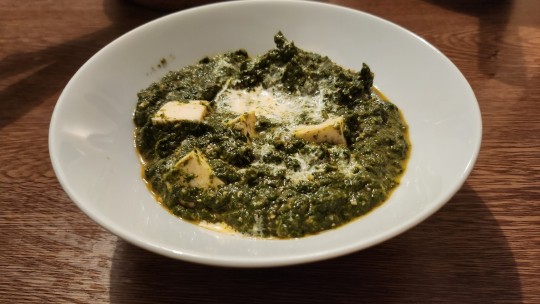
Hackle-lo and Scuttle Curry
One of the Telvanni Peninsula's most famous dishes, this simple, mild curry of hackle-lo and firm scuttle is delightfully rich and flavourful, yet simultaneously mild and balanced. Serve with wickwheat flatbread or steamed saltrice. Suitable for vegetarians! For a vegan version, replace paneer with tofu, and butter with coconut oil.
You will need:
225g paneer, cut into generous cubes (Indian cottage cheese CANNOT be substituted with regular cottage cheese! If you can't find paneer, use tofu or fresh mozzarella)
125g baby spinach
2 onions, finely diced
2 tbsp concentrated tomato purée
3 tbsp unsalted, unroasted cashews
1 tsp ginger paste
5 cloves garlic, minced
2-3 green chilis, sliced (like finger chilis or even fresh jalapeños), optional if you prefer it mild
1/2 tsp garam masala
2 cloves
2 cardamom pods, crushed lightly
1 tsp cumin
1 tbsp cinnamon
2 tbsp sugar
175ml water
2 tbsp butter
Coconut oil or vegetable oil
Salt and pepper, to taste
Cream, to serve (optional)
Method:
Combine the cloves, cardamom, cumin, and cinnamon in a pot, and gently cook on low heat with the butter and 1 tbsp coconut oil to release the aroma.
Toss in half the onions and fry until golden brown. Add the ginger paste and minced garlic, and continue to fry until they release their aroma. Add the tomato purée, salt and pepper, sugar, and garam masala. Continue stirring until well combined, then remove from heat, add the water, and purée until smooth with a blender or immersion blender. Set aside.
In a wok or large pot, fry the rest of the onions and chilis until glossy and aromatic. Add the spinach, and gently stir fry until the spinach has wilted and released most of its water. The spinach should still be green and not overcooked.
Transfer to a blender or use an immersion blender once again. Add the cashews. Purée until smooth and transfer to a bowl.
Put the tomato purée mix back on the heat and bring to a gentle bubble, then immediately remove from the heat and add the spinach purée. Stir until totally incorporated. Throw in your paneer and gently stir until well coated in curry.
Serve hot immediately, with either basmati rice or naan/roti on the side. Drizzle with cream to serve, if desired.
#the elder scrolls#tes#food#cooking#Recipe#Recipes#Indian#Indian food#Palak paneer#Saag paneer#Cheese#vegetarian recipe#vegetarian recipes#vegan cooking#Vegan#Vegan food#Hackle-lo and Scuttle Curry#Curry#World building#worldbuilding
248 notes
·
View notes